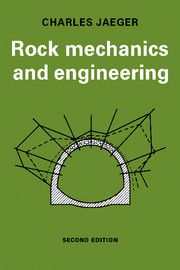Book contents
- Frontmatter
- Contents
- Preface
- Preface to the first edition
- Part 1 Introduction to rock mechanics
- Part 2 Rock material and rock masses
- Part 3 Rock mechanics and engineering
- Part 4 Case histories
- 12 Dam foundations and tunnelling
- 13 Incidents, accidents, dam disasters
- 14 The Vajont rock slide
- 15 Two examples of rock slopes supported with cables
- 16 Three examples of large underground hydro-power stations
- References
- Appendix 1 Comments on the bibliography
- Appendix 2 Measurement conversion tables
- Appendix 3 Table of geological formations and earth history
- Appendix 4 Some petrographic properties of rocks
- Author Index
- Index of geographical names, dam sites, reservoirs, tunnels and caverns
- Subject Index
- Frontmatter
- Contents
- Preface
- Preface to the first edition
- Part 1 Introduction to rock mechanics
- Part 2 Rock material and rock masses
- Part 3 Rock mechanics and engineering
- Part 4 Case histories
- 12 Dam foundations and tunnelling
- 13 Incidents, accidents, dam disasters
- 14 The Vajont rock slide
- 15 Two examples of rock slopes supported with cables
- 16 Three examples of large underground hydro-power stations
- References
- Appendix 1 Comments on the bibliography
- Appendix 2 Measurement conversion tables
- Appendix 3 Table of geological formations and earth history
- Appendix 4 Some petrographic properties of rocks
- Author Index
- Index of geographical names, dam sites, reservoirs, tunnels and caverns
- Subject Index
Summary
General information
The Vajont reservoir is located in the lower reaches of the river bearing the same name, not far from its confluence with the River Piave. The Vajont dam, a dome-shaped shell, built by the Società Adriatica de Elettricità (Chief Engineer Carlo Semenza), is the highest arch dam in the world, being 265 m high with a 160 m chord, which spans a very deep and narrow gorge. Several plaster models were built for testing the dam and its deformations under full load. The rock on both sides of the gorge had been skilfully reinforced (sections 6.6.1(3) and 11.4.1(1)).
During the night of 9 October 1963, a mass of rock estimated at 200–300 million m3, broke loose from the sides of Mount Toe and crashed into the reservoir below in which the water level was about 700 m above sea level. (The dam was designed for a water storage level of 722·5 m a.s.l.) Almost 2500 lives were lost when a wave overtopped the dam and flooded the Piave Valley, destroying the small town of Longarone. The Vajont dam was not damaged and it still stands as the highest arch dam in the world, proof of the remarkable work done by the Italian engineers when reinforcing the fractured rock abutments on both sides of the gorge.
The slide, mainly rocky formations which, though strongly fractured, have maintained many of their original morphological features, extended from the close vicinity to the dam to as far as 1800 m upstream.
- Type
- Chapter
- Information
- Rock Mechanics and Engineering , pp. 402 - 423Publisher: Cambridge University PressPrint publication year: 1979
- 1
- Cited by



